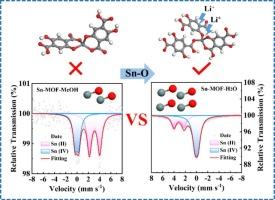通过用于锂离子电池负极材料的连续微通道反应器在 Sn-MOF 中构建 Sn-O 键
IF 6.9
2区 材料科学
Q2 CHEMISTRY, PHYSICAL
引用次数: 0
摘要
由于锡基金属有机框架(Sn-MOFs)具有作为高性能负极材料的潜力,因此有关其在锂离子电池中的应用的研究引起了人们的极大兴趣。在这项工作中,使用微通道反应器合成了 Sn-MOFs,以甲醇和水为溶剂实现了连续生产。对比分析表明,与 Sn-MOF-MeOH 相比,Sn-MOF-H2O 中 Sn(Ⅳ)的比例大幅增加,从 39.8% 增加到 68.4%。这种增加增强了与氧的配位,从而提高了锂存储性能。电化学评估显示,与 Sn-MOF-MeOH 相比,Sn-MOF-H2O 在首次放电容量、首次库仑效率、比能量和较低阻抗方面都更胜一筹。即使在 100 mA g-1 的电流密度下循环 200 次后,Sn-MOF-H2O 的比容量仍保持在 929.8 mAh g-1 的水平,超过了 Sn-MOF-MeOH 的 446.1 mAh g-1 容量。Sn-MOF-H2O 性能的提高可归因于其丰富的 Sn-O 键合,这有助于更好地适应锂插入和提取过程中的体积变化。这些键合作用确保了有机基质中锡原子的均匀锚定或释放,从而抑制了颗粒的生长和聚集。这些发现强调了以水为溶剂合成的 Sn-MOFs 在先进锂离子电池应用中的潜力。本文章由计算机程序翻译,如有差异,请以英文原文为准。


Constructing Sn-O bonds in Sn-MOF via a continuous microchannel reactor for lithium ion battery anode materials
Research on Sn-based metal–organic frameworks (Sn-MOFs) for lithium ion batteries has attracted substantial interest owing to their potential as high-performance anode materials. In this work, Sn-MOFs were synthesized using a microchannel reactor, enabling continuous production with methanol and water as solvents. Comparative analysis revealed a substantial increase in the percentage of Sn(Ⅳ) in Sn-MOF-H2O, increasing from 39.8 % to 68.4 %, in contrast to Sn-MOF-MeOH. This increase resulted in enhanced coordination with oxygen, thereby improving lithium storage performance. Electrochemical assessments showcased Sn-MOF-H2O’s superiority in first discharge capacity, first Coulomb efficiency, specific energy, and lower impedance over Sn-MOF-MeOH. Even after 200 cycles at a current density of 100 mA g−1, Sn-MOF-H2O maintained a specific capacity of 929.8 mAh g−1, surpassing Sn-MOF-MeOH’s capacity of 446.1 mAh g−1. The enhanced performance of Sn-MOF-H2O can be ascribed to its abundant Sn-O bonding, facilitating better accommodation of volume changes during lithium insertion and extraction. These bonding interactions ensure uniform anchoring or release of Sn atoms in the organic matrix, thus curbing particle growth and aggregation. These findings underscore the potential of Sn-MOFs synthesized with water as solvents for advanced lithium ion battery applications.
求助全文
通过发布文献求助,成功后即可免费获取论文全文。
去求助
来源期刊

Applied Surface Science
工程技术-材料科学:膜
CiteScore
12.50
自引率
7.50%
发文量
3393
审稿时长
67 days
期刊介绍:
Applied Surface Science covers topics contributing to a better understanding of surfaces, interfaces, nanostructures and their applications. The journal is concerned with scientific research on the atomic and molecular level of material properties determined with specific surface analytical techniques and/or computational methods, as well as the processing of such structures.
 求助内容:
求助内容: 应助结果提醒方式:
应助结果提醒方式:


